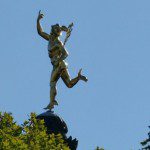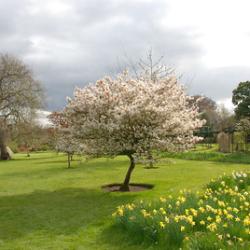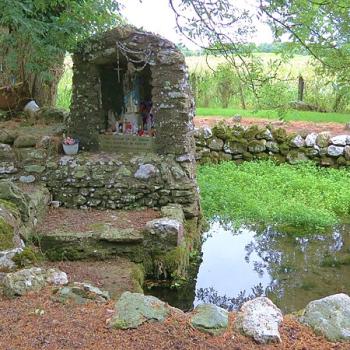Instead of just April Fool’s Day how about April Fool’s Month? Current events can be depressing and alienating. Perhaps it seems a little disrespectful to celebrate the Fool with so much suffering and strife all around. But consider this. Rather than recoiling and withdrawing, wouldn’t it be more satisfying to model a perspective which catalyzes a shift in the conversation? How do we go forward?
Central to this process is overcoming fear. The fool is fearless, valuing adventure and openness above all, with an attitude of expecting the best possible outcome. Throughout history leaders and heroes have depended on their trickster sidekicks, such as jesters, informers, and seers, for help in governing, outsmarting enemies, and providing comic relief. In many depictions of the fool, the figure is often androgynous. She or he applies.
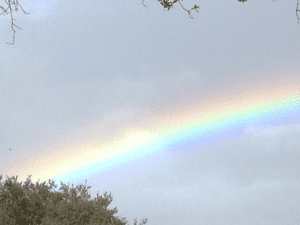
The Rainbow
Among symbols linked to the fool is the rainbow. Its sudden appearance often inspires helpful emotional states. The unification of the range of colors is empowering, healing and spiritually uplifting.
In numerous cultures, the rainbow signifies the union between sky and earth with the rainbow serving as a bridge between the two. In many early traditions and in present earth-based viewpoints the earth and sky are both sacred. We have just finished a powerful eclipse season in the sky which bookended the Spring Equinox, calling forth opportunities for robust new beginnings. (See my March, 7, 2016 column.) While we may not all have actually seen a rainbow recently, they are worth imagining frequently and observing in varied artistic productions.
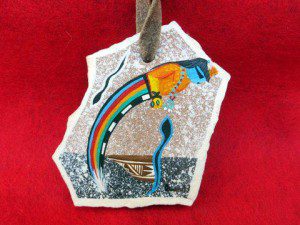
The rainbow inspires Native cultures worldwide. I found this rendition painted on a pottery chard in a museum shop years ago. It references lore about the Great Spirit coming to a human. She/He is receiving spiritual initiation directly from the essence of the earth through the voice of a serpent and from the skies through the rainbow.
The Fool card in the Tarot
The colorful vestment of this Fool from the Rider-Waite Tarot card deck embodies many colors. She/He radiates courage and creativity; unwavering self-respect and openness to new possibilities come to mind. A sense of humor built on innate trust is implied in the way this figure is walking toward the edge of the precipice.
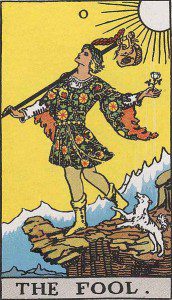
The fool in the tarot for me summarizes what we need now. This card occurs at the beginning and the end of the series of cards that depict a journey. It stands for the cyclical nature of living. When we reach an end of one phase, a new one unfolds. We are all at some stage of the life cycle which is an organic process of birth, living, dying and rebirth at the heart of earth-centered spiritual perspectives. So it goes also with the way events unfold. Why not keep the Fool in our visualizations during April to set the stage for the unfolding of the contentious months ahead?
The perspective of unfolding cycles provides a way to deal with the pressure of negative and hateful rhetoric. The fool is content to be on an adventure and is willing to engage in empathy. The stranger is welcomed because they have a story to tell that benefits the whole. We are better off if we admit that someday we will need the help and understanding of others.
The Fool is an old hand at dealing with strife. Rainbows frequently appear following a storm. It is not that we do not feel melancholy or despair but the Fool is the one who performs antics that enliven, amuse and sooth us.
The Fool in Art
This lithograph, which I acquired some years ago, is a “foolish” image that gives hope, levity and a reminder of the joys community can prompt, especially in times of conflict. The artist, Marc Chagall had to flee persecution several times during his life. Yet he maintained his sense of hope.
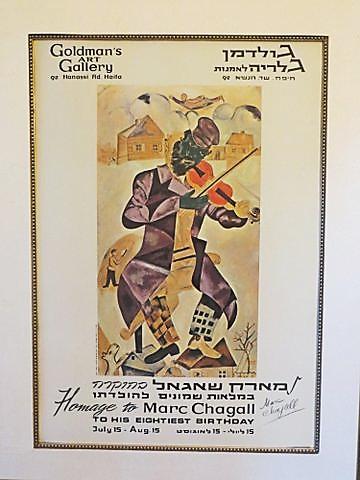
As a young man he was an active participant in the Russian Jewish Theater that began after the 1917 revolution. He is well-known for his depictions of Russian Jewish village life. The image on this poster was originally featured on one of four large banners that introduced the Moscow State Yiddish Theater in Russia in the 1920s. The four individual panels are devoted to allegorical depictions of music, dance, theater and literature.
Chagall created an entire environment for his work, taking over the auditorium and theater. He painted murals to cover the walls, ceiling and even the curtain on the stage. In the aftermath of the political turmoil of 1937, Chagall’s murals vanished from public view.
This figure entitled Music wears a prayer shawl underneath his coat, suggesting a connection between religion and music. Music that speaks to the freedom of the soul is another “foolish” ally that is especially valuable in today’s difficult times.
Until 1973 when Chagall returned to the Soviet Union to sign the murals, they were stored by the Tretyakov Gallery in an off-site warehouse. This is especially important to me since this lithograph was created when Chagall had no access to the originals he had once created. Somehow he maintained the connections with his youthful visions, choosing this image to depict his frame of mind in old age. Chagall passed on March 28, 1985 at the age of 97. Beginning in 1990 the murals were seen publicly in the West and elsewhere. He would have been pleased, no doubt.
Even though these depictions were produced by artists from widely divergent cultures, they speak a similar wisdom tied to a communal sense of joy, adventure, tolerance, and hope. The unity of color, like the rainbow, and the movement and joy of the Fool each emanates, can be a powerful centering influence in times of difficulty and contention. Maintaining a sense of humor and linking to others who share this perspective, as well as reaching out in non-violent good will might just shift the conversation and open hearts.


